As an Amazon Associate I earn from qualifying purchases.
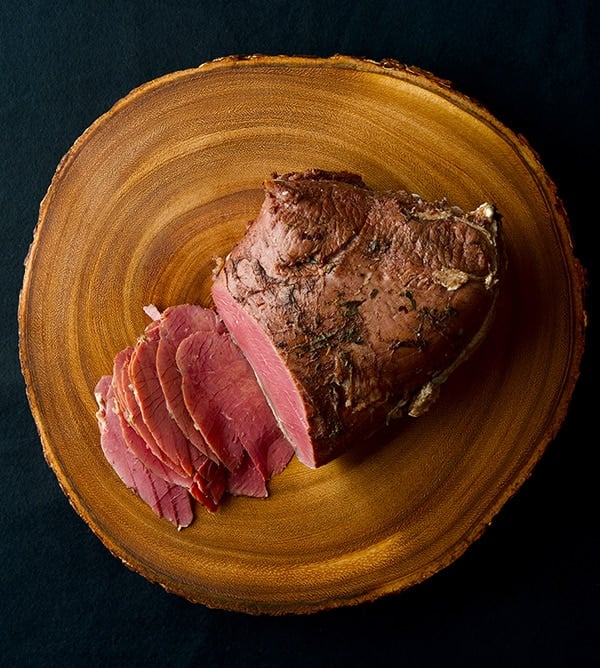
Corning venison began as one of those, “why not?” experiments that turned out far better than I had expected. I don’t know why I was so worried — I like corned beef, and how different is venison, anyway?
Corning venison at home is so good in fact that any deer hunter out there really ought to learn this technique — you will get far more enjoyment out of the leg roasts from your venison.
I typically use whole-muscle roasts from the hind leg to do this. Big sirloin roasts, rump roasts, the “football roast,” and such. But any big hunk of venison will work. The advantage of the whole-muscle roasts is less sinew and connective tissue, which takes hours to break down. I suppose you could use the backstrap, but why would you?
Lovers of hash might want to corn shoulder or neck roasts, then simmer them so long they begin to fall apart. The extra connective tissue in these cuts makes for a moister hash.
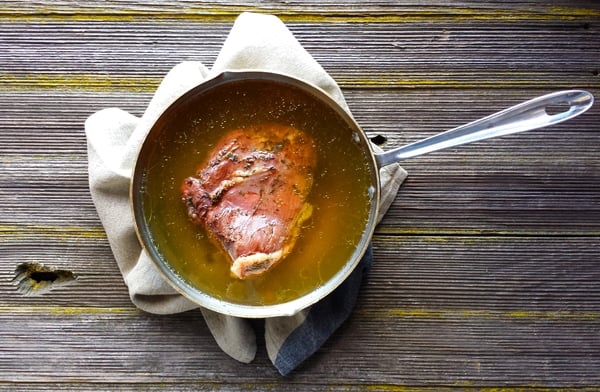
The technique is simple: Brine your meat, then simmer it into tenderness. It takes several days, but it isn’t labor-intensive at all. Once made, corned venison is great hot or cold, with root vegetables, cabbage, cold in sandwiches (how I eat most of my corned venison), or chopped into hash.
A word on nitrites. I use them, for color, for flavor and for safety. Can you do this without pink salt? Yes, but your meat will be gray, you will lose some flavor, and there is an ever-so slight chance you might pick up botulism — not a large chance, but as botulism is one of the most toxic substances known to man, I’d say use the nitrite. You can buy it online here at The Sausage Maker.
Once made, you can keep corned venison in the fridge for a couple weeks, or freeze it for a year.
Corned Venison
Ingredients
- 1/2 gallon water
- 1/2 cup kosher salt
- 1/3 cup sugar
- 1/2 ounce Instacure No. 1 (sodium nitrite)
- 1 tablespoon cracked black pepper
- 1 tablespoon toasted coriander seeds
- 6 bay leaves, crushed
- 1 tablespoon mustard seeds
- 1 tablespoon dried thyme
- 1 teaspoon caraway seeds
- 1 cinnamon stick
- 5 chopped garlic cloves
- A 3 to 5 pound venison roast
Instructions
- Add everything but the roast to a pot and bring it to a boil. Turn off the heat and cover, then let it cool to room temperature while covered. This will take a few hours. Meanwhile, trim any silverskin you find off the roast. Leave the fat. Once the brine is cool, find a container just about large enough to hold the roast, place the meat inside and cover with the brine. You might have extra, which you can discard.
- Make sure the roast is completely submerged in the brine; I use a clean stone to weigh the meat down. You can also just flip the meat every day. Cover and put in the fridge for 5 to 7 days, depending on the roast's size. A 2-pound roast might only need 4 days. The longer you soak, the saltier it will get -- but you want the salt and nitrate to work its way to the center of the roast, and that takes time. Err on extra days, not fewer days.
- After the alloted time has passed, you have corned venison. To cook and eat, rinse off the meat, then put the roast in a pot just large enough to hold it and cover with fresh water. You don't want too large a pot or the fresh water will leach out too much flavor from the meat -- it's an osmosis thing. partially cover the pot and simmer gently -- don't boil -- for at least 3 hours and up to 5 hours. The meat itself will be cooked in an hour or less, but you want the sinews and connective tissue in the roast to soften and that takes time.
- Eat hot or cold. It is absolutely fantastic with good mustard and some sauerkraut on a sandwich.
Notes
Nutrition
Nutrition information is automatically calculated, so should only be used as an approximation.

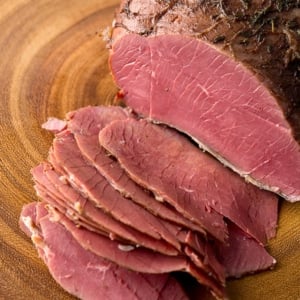
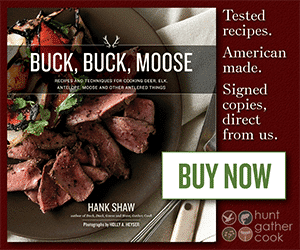
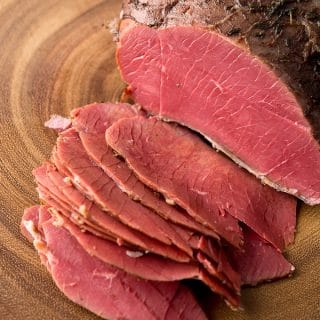
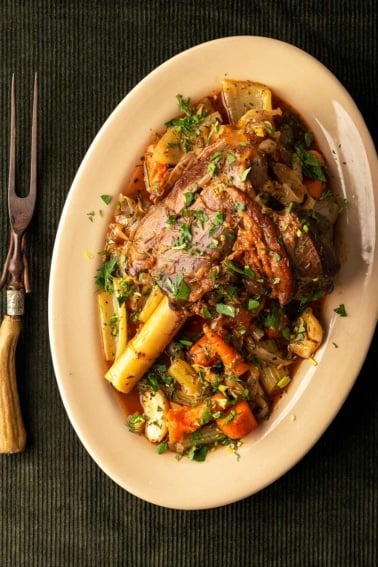
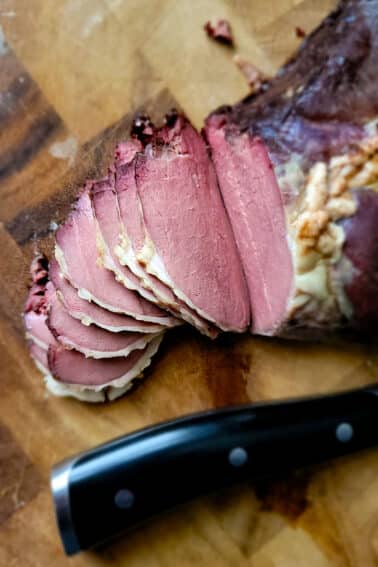
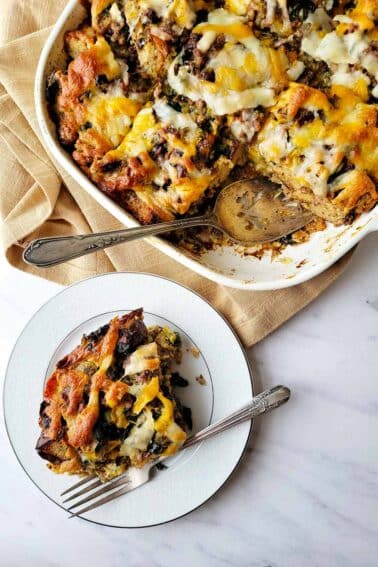
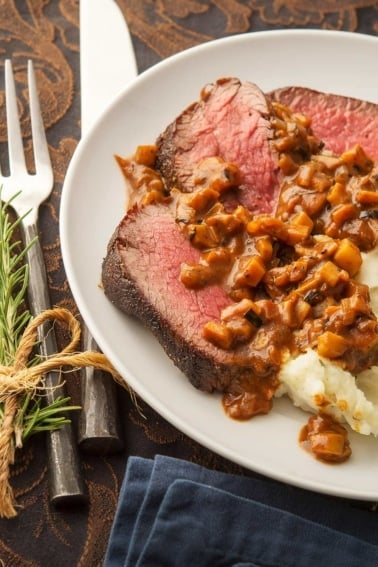
This is so delicious! I have made this every St Patrick’s day for the past few years and we love it. My husband now makes sure he gets multiple roasts so we can enjoy it throughout the year.
Hello Hank,
I was wondering if you freeze the cooked corned venison in the cooking liquid?
Thanks!
Brendan: No, I take it out of the liquid to freeze.
Excellent recipe! I was able to feed venison to folks that claim they would never like it and they LOVED it! Thank you!
Okay here’s an update. After the meat rested in the frig it was way better. I think it was the spice that smelled soapy not the cure. My spouse said it was great from day one but my sniffer is more sensitive. I still don’t like the idea of propylene glycol in my food, and I did have to make the slices thicker than the pics because it wa crumbly but tasted better after a day or two. I will try again and maybe modify the spice a little more to my liking.
I thought the cure gave it an off putting soapy flavor, plus the propylene glycol in it is scary. It was pretty though. When I tried to slice it it was crumbly. Next time I won’t use cure. Plus I couldn’t really taste the spices at all. I don’t know what I did wrong
Where are you getting propylene glycol in this recipe? It’s not mentioned anywhere on the whole page. Maybe that is your problem.
I don’t see PPG listed in my instacure (sodium nitrite). At any rate, PPG is present as an additive in soup mixes, seasonings, baking mixes….. it is considered safe by the FDA. Yes, I know that science no longer means anything, so by all means, take your chances with the most most potent toxin known to man.
Propylene glycol??? Best check to see if you are on the same page as others…..
I have a deboned venison neck (two pieces one off each side) I’d like to make hash with. Anything you would change when doing this vs. a large whole muscle roast?
Brian: Yes, I’d cook it much longer, until it wants to fall apart.
This is excellent. I make corned venison from leg roasts every season. I also cook them sous vide and just put them in the freezer in their bags. Everyone who has tried it asks for this recipe.
I love the recipe and made it, frozen it, then cooked later. But I would like to pressure can this corned venison. Should I pack raw? Or cook first then pressure can? Have you tried that?
Jennie: I’ve not tried that. But my instinct says to pack it cured but not cooked because you generally pressure can meat for more than an hour.
Cure worked super well. Cooked it sous vide at 175 – was good but a little dry for me, I’ll try it at a lower temperature next time. Sliced it up and made Reubens.
I’ve cooked this 10+ times and probably made my wife marry me. Hank Shaw is my spirit animal.
Hello Hank! This is my first time making your recipe. I’ve used cuts from the hind quarter/thigh. I’m only going to cook a little when needed. should I freeze it with the Brine or without? Thanks! Erin.
Erin: Freeze without the brine.
Delicious. Brining was easy. Used the corned venison to make reubens. As per another commenter, I cooked it sous vide at 175 for about 11 hours. Next time I’ll drop that temperature a bit to see if I can get a more moist product (it turned out a little drier and more crumbly than I’d prefer, not that you could notice that once it was in a sandwich with dressing and melted cheese).
I have a few really small venison roasts. 1 to 1.5 lbs. Would your corned and pastrami recipes work with roasts this small?
Jason: Yes, it should work fine.
I also have some smaller roasts. If I use this recipe with 2 2 lb roasts should I cure closer to the lower end (5 days) since the roasts are smaller? Or towards the longer end (7 days) since the total weight is larger?